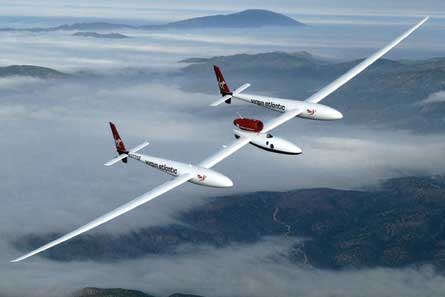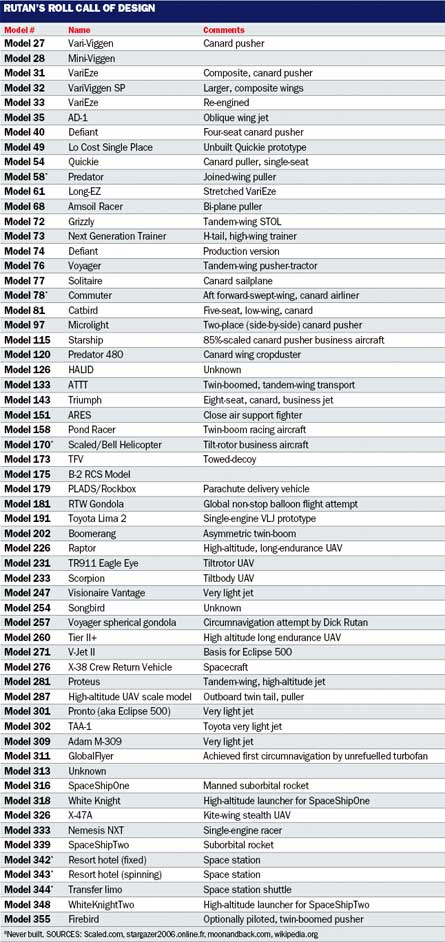New ideas are powerful things, even when they are wrong. Aviation legend Dick Rutan is not criticising his younger brother when he says the aerodynamic ideas of the now-retired founder of Scaled Composites are generally wrong two times out of three.
After a 46-year career as a test pilot and pioneering aircraft and spaceship designer, a list of Burt Rutan's failed projects could fill the world's most eclectic aviation museum.
But, oh, the ideas that worked...
A partial list of successful projects includes lightplanes (Vari-Eze, Long-EZ, Quickie, Defiant) designed to be almost impossible to stall; an admittedly dangerous aircraft design (Voyager), no heavier than a Beechcraft King Air, which circumnavigated the globe nonstop; and a privately-funded space vehicle (SpaceShipOne) configured to assume the perfect profile for safe re-entry.
 |
|---|
© NASM |
The Virgin Atlantic GlobalFlyer which achieved the first circumnaviation of the world by unrefulled turbofan |
As diverse a sample as Rutan's successes, the full list of his models and projects is even broader. No pocket of the aerospace world, it seems, escaped the curious meddling of his Mojave, Cailfornia-based enterprise.
Spacecraft, rockets, fighters, trainers, unmanned air vehicles, transports, helicopters, balloons, sailplanes, airliners, business aircraft, very light jets, general aviation and racers all owe a debt to the learning achieved by Rutan successes, and perhaps even more so by his failures.
No configuration has been left untried. From forward canard-aft wing pusher engine combinations, to tandem-wings, to joined wings, to staggered wings, to asymmetric twin-booms and feathered tails, Rutan's ideas seemed almost defiantly unconventional.
 |
|---|
© Rex |
Rutan himself, worth a salute |
His firm, Scaled Composites, stands out in an industry that increasingly shrinks from taking bets that are deemed too risky.
Rutan has described Scaled's working environment as a place where courage is applauded and multiple failures are expected. No project is worth Scaled's time accepting unless half of those involved believe that the goal is impossible.
Almost as important as the pioneering aircraft designs to Rutan's legacy was the working culture he insisted upon in the aerodynamic laboratories he controlled. First, it was the Rutan Aircraft Factory, and, after 1983, it was Scaled Composites, which started with only six workers and now employs more than 400.
Scaled belongs to the lineage of the vision of Lockheed Skunk Works founder Kelly Johnson, one of Rutan's declared heroes. Johnson famously cancelled the D-21 stealth drone after losing faith in his own design, and refunded the government for the costs. Johnson's singular approach became the template for the Scaled Composites team.
 |
|---|
© USAF |
The Proteus tandem-wing, high-altitude jet |
In the late 1980s, Rutan agreed to design the advanced technology tactical transport (ATTT), a futuristic C-130 replacement, for the Defense Advanced Research Projects Agency (DARPA).
But Rutan balked when the contract terms called for establishing a team of government auditors on Scaled's property. Rutan's approach requires a pool of engineers to move from project to project, solving problems as they arise. Micro-managing billable hours and parts numbers are anathema to the company's working culture. According to Rutan, Scaled's costs were so low that the government erased the terms, and the project was started.
Rutan's approach that yielded the Vari-Eze, Voyager and SpaceShipOne worked best when Scaled remained in control of the design and the manufacturing. Joint projects launched with corporate partners had a more chequered history.
 |
|---|
The StarShip, a costly blunder |
Possibly Rutan's worst mistake is the Starship, a costly blunder that nearly ruined Beech. But its failure in the marketplace is symbolic of the risks that Rutan was willing to take, if he believed in the project.
A decade later, the company took perhaps its riskiest bet, launching the SpaceShipOne programme to prove commercial spaceflight was feasible. Over five days in October 2004, Rutan's team completed two suborbital flights within five days. Seven years later, the commercial spaceflight industry is finally dawning, with the Virgin Galactic/Scaled Composites VMS Enterprise (SpaceShipTwo) firmly in the lead.
Dick Rutan, addressing the audience of the Collier Awards in May as the keynote speaker, lamented that one unintended consequence of one of his brother's successes is that it stopped further research. No one kept up the pursuit of ultra-long-endurance, manned flight after co-pilots Dick Rutan and Jenna Yaeger landed Voyager safely in Mojave on 23 December 1986.
The around-the-world flight of Voyager broke all known boundaries of powered flight endurance and established the co-pilots Dick Rutan and Jenna Yaeger and the designer as legends in the aviation industry. But that success is where progress stopped.
 |
|---|
Source: Flight International




















